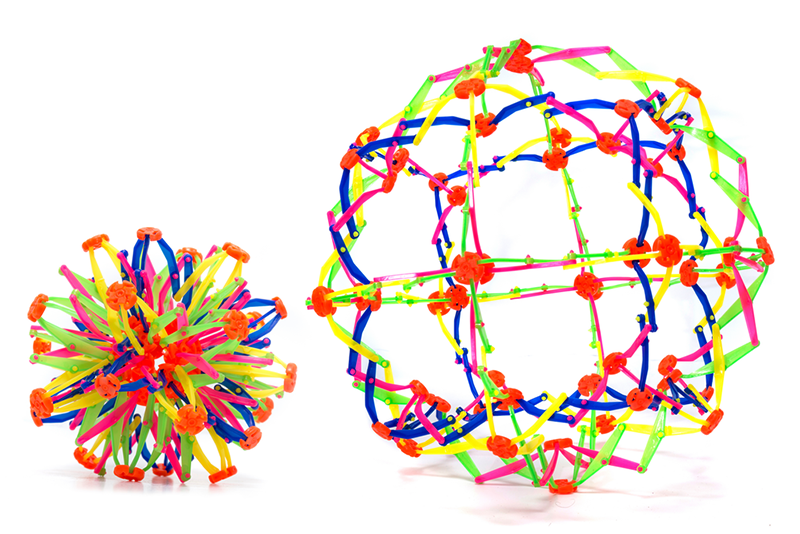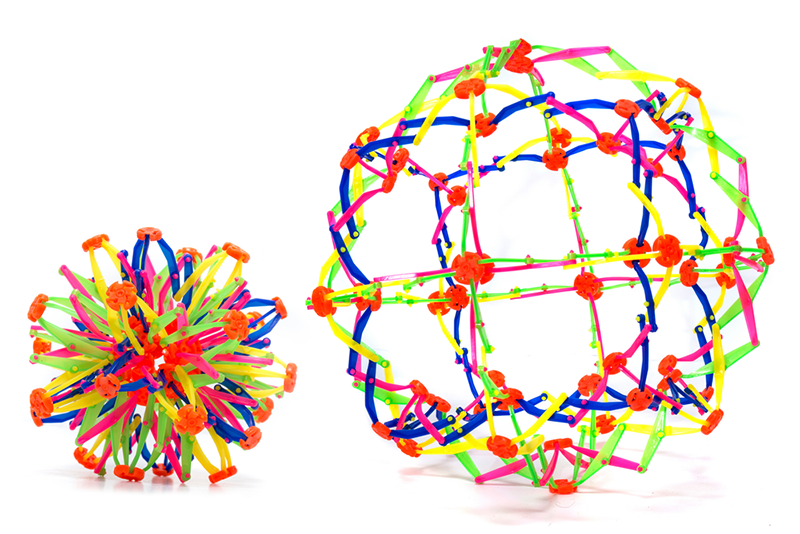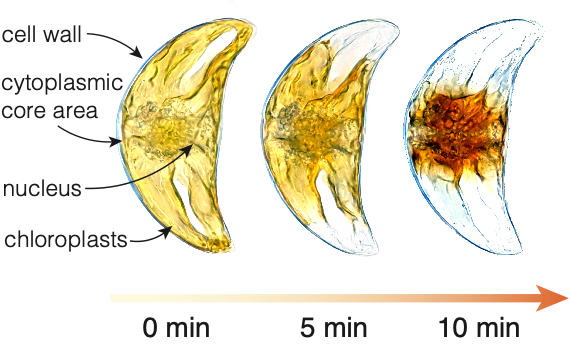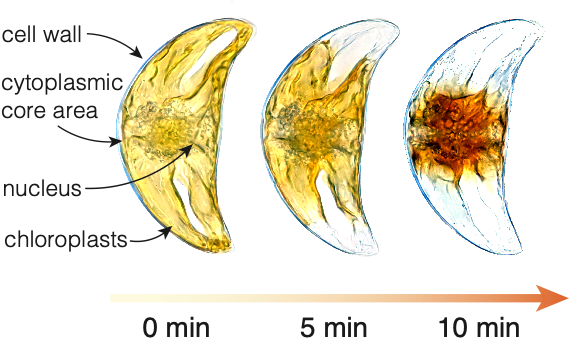Glowing Algae Change Morphology to Avoid Light
On a bright summer’s day, most motile creatures can quickly move into the shade to avoid the harmful effects of the midday Sun. Plants and photosynthetic algae also need to minimize their exposure to the Sun’s intense rays, but they must do so without changing their location. Now researchers at the University of Amsterdam have found an explanation for how algae can achieve this feat [1]. Their finding answers a fundamental question about how nonmotile organisms avoid light damage and could inform material design for light-harvesting applications.
Photosynthetic organisms make their living during daylight hours. Using pigment-filled structures called chloroplasts, plants and algae generate the fuel they need to survive by converting solar energy into chemical energy. But if the Sun’s intensity is too strong, a plant might absorb more energy than it can handle, and the plant can die.
When extremely strong light shines on a land-based plant, the many disk-shaped chloroplasts inside each of the plant’s leaf cells collectively rearrange, taking on a pattern that optimizes light uptake while minimizing cell damage [2]. Observations made by marine biologists suggest that the chloroplasts in dinoflagellates—single-celled aquatic algae—also change shape when exposed to strong light. But because each dinoflagellate cell contains only one chloroplast, researchers suspected that the mechanism by which its chloroplast changed shape differed from that of the chloroplasts in terrestrial-plant cells. But that hypothesis remained unconfirmed.
To uncover the puzzle of how dinoflagellate cells protect themselves from the Sun, the University of Amsterdam team studied an alga called Pyrocystis lunula, the cells of which are bounded by a rigid wall and contain a single chloroplast. This alga is found in warm waters and is famous for its ability to make the sea glow blue (see Focus: A Light Squeeze). P. lunula also performs different light-driven processes in the daytime (photosynthesis) and the nighttime (bioluminescence), providing the researchers with a way to studying different chloroplast states.
The researchers probed the light-driven behavior of individual P. lunula cells by exposing them to white, blue, and red lights of varying intensities. Using a microscope, they monitored changes in the morphology of each cell’s chloroplast during these exposures.
When exposed to bright white light (daylight conditions), the researchers observed each cell’s chloroplast rapidly contract, with its surface area decreasing by 40% within 5 minutes. Calculations indicate that this contraction reduces the amount of light a P. lunula cell can absorb by up to 10%. Switching then to dim red light (photosynthetically favorable conditions), the researchers found that the chloroplast expanded, returning to its starting size within half an hour. These results clearly indicate that the shape of the chloroplast depends on the properties of the incoming light, says team member Nico Schramma.
Looking at the images more closely, the researchers found that the internal structure of a P. lunula’s chloroplast resembles that of a knitted sweater—an interconnected porous network of filaments. Such a structure is known to be able to contract and expand in all directions. To explain, Schramma likens the chloroplast to a Hoberman sphere, a child’s ball toy that is often used for breathing exercises. When squeezed in one dimension, a regular ball will expand in another dimension, because of conservation of volume. A Hoberman sphere, however, contracts in all directions even if squeezed in only one. Analysis of the time-dependent dynamics of the P. lunula chloroplast confirms that it behaves like such a sphere, deforming and buckling inward when compressed.
Vivek Prakash, a biophysicist at the University of Miami, calls the study “beautiful.” As well as bringing together various concepts from physics and mathematics (network dynamics, topology, mechanics, and metamaterials), he says the study “provides important quantitative methods and tools that will significantly benefit the light-biology research community.”
–Rachel Berkowitz
Rachel Berkowitz is a Corresponding Editor for Physics Magazine based in Vancouver, Canada.
References
- N. Schramma et al., “Morphodynamics of chloroplast network control light-avoidance response in the non-motile dinoflagellate Pyrocystis lunula,” bioRxiv: 2024.04.30.591832 (2024).
- N. Schramma et al., “Chloroplasts in plant cells show active glassy behavior under low-light conditions,” Proc. Natl. Acad. Sci. U.S.A. 120 (2023).







